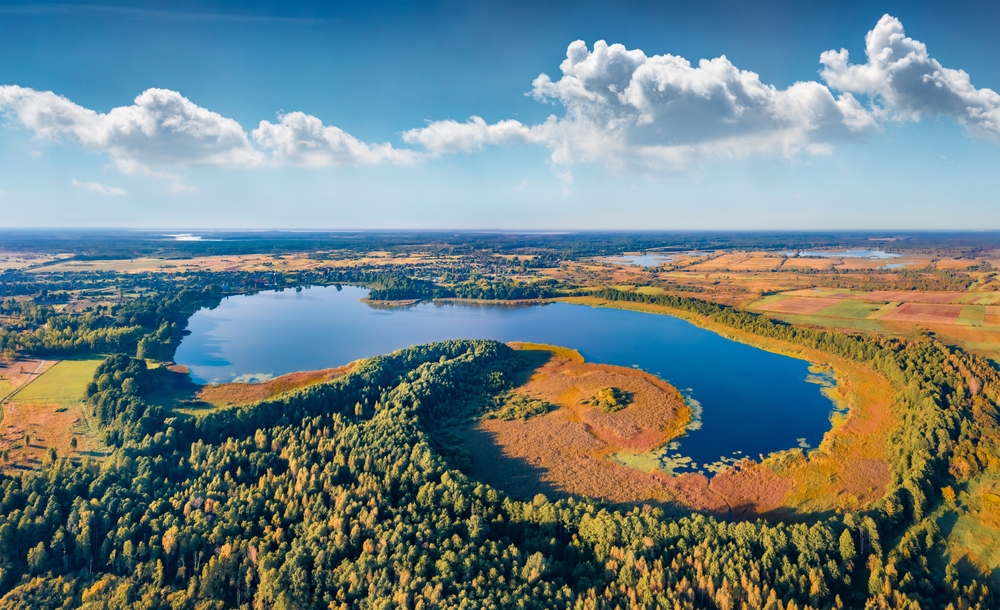Shatsky Overview
Shatsk National Natural Park, known locally as Шацький національний природний парк (Shatskyi Natsionalnyi Pryrodnyi Park), is a protected area in northwestern Ukraine, situated in Volyn Oblast near the town of Shatsk.
Established in 1983, the park covers approximately 490 square kilometers (190 square miles), with 188 square kilometers (73 square miles) designated for permanent use. It is one of Ukraine’s most significant natural reserves, renowned for its unique landscapes and biodiversity. The park is part of the West Polesie Transboundary Biosphere Reserve, emphasizing its international ecological importance.
The park’s terrain is a diverse mosaic of lakes, wetlands, forests, and meadows. It is best known for the Shatsky Lakes, a collection of more than thirty lakes that collectively span nearly 70 square kilometers (27 square miles), making it one of the largest lake groups in Europe.
The most famous of these is Lake Svitiaz, Ukraine’s deepest lake, covering 25.2 square kilometers (9.7 square miles) and plunging to a depth of 58.4 meters (192 feet). This lake is particularly noted for its clear waters, sandy beaches, and a small island at its center, adding to its scenic charm. Other notable lakes include Pulemetske, Luky, and Pisochne, each contributing to the hydrological richness of the region.
The park is also heavily forested, with pine trees dominating the landscape alongside alder and birch in the low-lying areas. Grasslands and marshes provide additional ecological diversity, supporting a range of plant and animal species.
Shatsk National Natural Park is home to a diverse array of wildlife. Among its 332 vertebrate species, visitors may encounter 55 mammal species, including elk, wild boar, roe deer, hares, and squirrels. More elusive inhabitants such as otters, badgers, polecats, and martens can also be found.
The park is particularly significant for birdlife, serving as an important stopover for migratory species. Commonly spotted birds include the great crested grebe, grey heron, mute swan, various species of ducks, and birds of prey such as the western marsh harrier. The lakes and wetlands are home to a variety of fish species, including common roach, common bream, northern pike, carp, European eel, and different catfish species.
Visitors are drawn to Shatsk National Natural Park for its tranquil lakes and outdoor activities. Lake Svitiaz, in particular, is a major attraction due to its crystal-clear waters and sandy shores. The park features ecological trails such as “Svitiazianka” and “Lisova Pisnia,” offering opportunities to explore its diverse habitats and observe wildlife.
Popular activities include swimming, boating, fishing, and birdwatching, with the summer months seeing an influx of tourists seeking relaxation and recreation in the park’s natural setting. The area offers a variety of accommodations, including youth camps, holiday hotels, sanatoriums, and private guesthouses, catering to different visitor preferences.
Conservation efforts in the park have been substantial. In 2002, Shatsk National Natural Park was included in the World Network of Biosphere Reserves as part of the West Polesie Transboundary Biosphere Reserve under UNESCO’s “Man and the Biosphere Programme.”
This designation highlights the park’s ecological importance on a global scale. However, challenges remain, particularly in balancing tourism with environmental protection. Water pollution, habitat degradation, and the impact of human activity continue to pose threats.
Scientific research and environmental monitoring are ongoing, aimed at mitigating these issues and ensuring the park’s ecosystems remain preserved for future generations.










































































